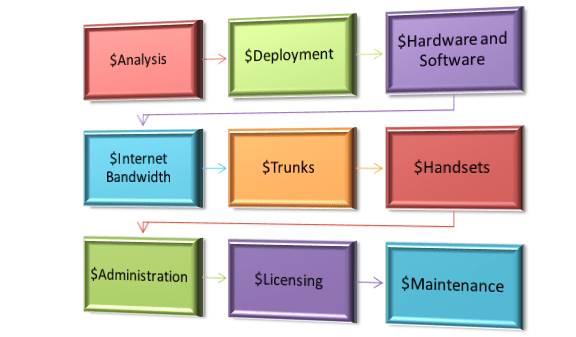I talked to a friend recently who was full of excitement over the news from his employer that the sales team (of which he belongs) was going to receive new smartphones. His excitement was easy to understand: the entire 50 person sales team was getting brand new iPhones that were going to replace their SIP handsets and older PBX desk phones. Considering the cost of smartphones and voice quality concerns, you understand my curiosity about what would drive the company to do such a thing. Given all the changes in the mobile market and where the future of telephony seems to be headed, I tried to follow the company logic.
Blog
Guide to Calculating TCO of Your Phone System
Cost is a major factor that drives virtually every decision a business owner makes. Not only is it important to look at the up-front costs of something, the total cost of ownership comes into play, too. For some companies, it might be worthwhile to lay out more capital in the short-term, if it parlays into long-term savings. For others, they might not use a product or service long enough to justify the initial set up costs. This is true of a hosted phone system, just like it is for anything else.
Price Wars Among Business VoIP Service Providers
If you’re like most businesses, price has always played an important role when deciding what telephony provider to work with.
Now, price isn’t, and never has been, the only point of consideration to take into account when selecting your telephony provider. You need to make sure your provider offers a reliable high quality business phone service, and you need to feel sure that provider offers a varied enough suite of telephony products to meet both your business’ current needs, and whatever needs it will develop as it continues to evolve. But, as long as these base-line points are hit, you will probably choose your telephony service provider based on price.
The Surprise Selling Point for Hosted PBX Solutions

If you asked us a couple years ago why our customers ultimately decide to purchase hosted PBX solutions we would have offered you the common-sense answers you expected to hear. We would have explained that our hosted PBX systems offered increased flexibility and control over traditional systems. We would have explained how our hosted PBX solutions could scale up and down, meeting our clients ever-changing needs with just a moment’s notice. We would have explained how our telephony solutions provided the ability to tie multiple locations to a single Hosted PBX solution, regardless of how remotely they were located.
Information or Telecommunications? How Regulation Affects Hosted PBX and Law Enforcement
Communications is a tightly controlled industry in the U.S. With new hosted PBX technologies, some issues have cropped up that caused the FCC to run into a snag when it comes to properly regulating them. Some of these might seem like simple semantics, but even something as minor as figuring out what to call a hosted PBX service can snowball into something more serious.
Look at it this way- there are separate regulations for information services and telecommunications services. Information services, like the internet, are not as tightly regulated as telecommunications services, like telephone services. So… how should regulators qualify Voice-over-IP systems? They’re essentially a telecommunications service, but one that relies on the internet. Do calls made over the internet qualify as phone calls, or as internet data content? Calling them an “internet content” would make internet-based phone services subject to far fewer regulations than traditional phone services. Needless to say, VoIP service providers are pushing for an information services classification, while traditional phone companies are lobbying for a telecommunications services classification.
Hosted PBX Unwrapped: VoIP Features Your Business Cannot Do Without
 If after careful research and deliberation your business has made the decision to upgrade to a hosted VoIP service, you are probably anxious to choose a Hosted PBX service provider and start reaping the many benefits of a hosted phone system. The first question on your mind is probably “What features does the business need?” VoIP Features such as voicemail, call waiting, and E911 are standard across providers of hosted VoIP. The advanced feature sets, however, can vary quite a bit in both: availability and implementation. When you select a service provider, you ultimately choose a set of features. In your search for a VoIP service provider, consider the following advanced features that go beyond the basics and provide your business increased flexibility and efficiency.
If after careful research and deliberation your business has made the decision to upgrade to a hosted VoIP service, you are probably anxious to choose a Hosted PBX service provider and start reaping the many benefits of a hosted phone system. The first question on your mind is probably “What features does the business need?” VoIP Features such as voicemail, call waiting, and E911 are standard across providers of hosted VoIP. The advanced feature sets, however, can vary quite a bit in both: availability and implementation. When you select a service provider, you ultimately choose a set of features. In your search for a VoIP service provider, consider the following advanced features that go beyond the basics and provide your business increased flexibility and efficiency.
No more SPIT!
This article is not a roaring plea from baseball fans. No, this article is about SPam over Internet Telephony or as it is often shortened—SPIT. Those annoying, unsolicited messages that clutter your email inbox have an ugly cousin that seeks to bombard your digital phone messaging system with pre-recorded messages and cause much more damage. The problem with SPIT is that if it isn’t controlled it can quickly eat up your valuable bandwidth and clog up your system, which can prevent legitimate callers from reaching you. There are software programs on the market to tackle SPIT. Many of these function similar to the tools used to control and prevent email spam.
VoIP Bandwidth: Quality vs. Quantity
Digital leased lines are no longer the favorites of bandwidth-hungry businesses. As many alternative sources of affordable Internet bandwidth became available, dedicated point-to-point leased lines begun to fall out of favor with many small businesses. Their relatively high cost, by today’s standards, per megabit of bandwidth make them unattractive in comparison to the generous shared bandwidth offers from various telecommunications and cable carriers. That said, it seems like rumors of their rapid demise are being greatly exaggerated. T-1 lines, for example, seem to be entering their 7th life as market for them is getting sudden support by those who had to deal with at least one DSL or Cable outage.
The Future of Unified Communications As a Service
Recent studies claimed that the market for cloud-based voice over IP services is expected to grow to $30 billion USD by the year 2013. These numbers might sound really encouraging, but what is the real future for Unified Communications As a Service (UCaaS)?
Here, in the U.S., UCaaS hosted PBX services are experiencing tremendous growth. Small businesses, especially in the current economic climate, are always looking for more efficient, less expensive ways to handle their telecommunications needs, and hosted telephony has served them admirably well thus far. Hosted PBX services give them access to a whole host of really sophisticated features, without relying on a large initial investment for equipment or set up.
How Can You Best Implement PBX Automation?
Introducing automation to your organization’s phone system will either be one of the wisest decisions you’ve ever made, or a potential debacle, depending on how well you implement the following best practices.
Hosted PBX Automation Step-by-Step
Get Everyone Involved
Even though it’s tempting to program auto attendant, routing tree and the flow of your callcenter without soliciting input from the rest of your organization, doing so can potentially alienate your employees and prevent you from reaping the benefits of their unique perspectives and insights. No one understands your customer’s desires and the inner workings of your current phone system better than your ground-level employees, and without their input you will never create the best possible organizational system for your organization’s new telephony experience.
Gather information and opinions from your organization’s decision makers, from your sales & marketing staff, and from those employees who actually man your phone lines day-in and day-out. It’s also wise to consult your telephony solutions supplier too, as those professionals understand the nuts-and-bolts of what has worked, and what hasn’t, for many of their past clients.
How you automate your phone systems needs to reflect the big picture of your organization, it’s branding and its core message, but it’s also a practical technological system your employees will utilize every day- so make sure they have a say regarding how it works.

